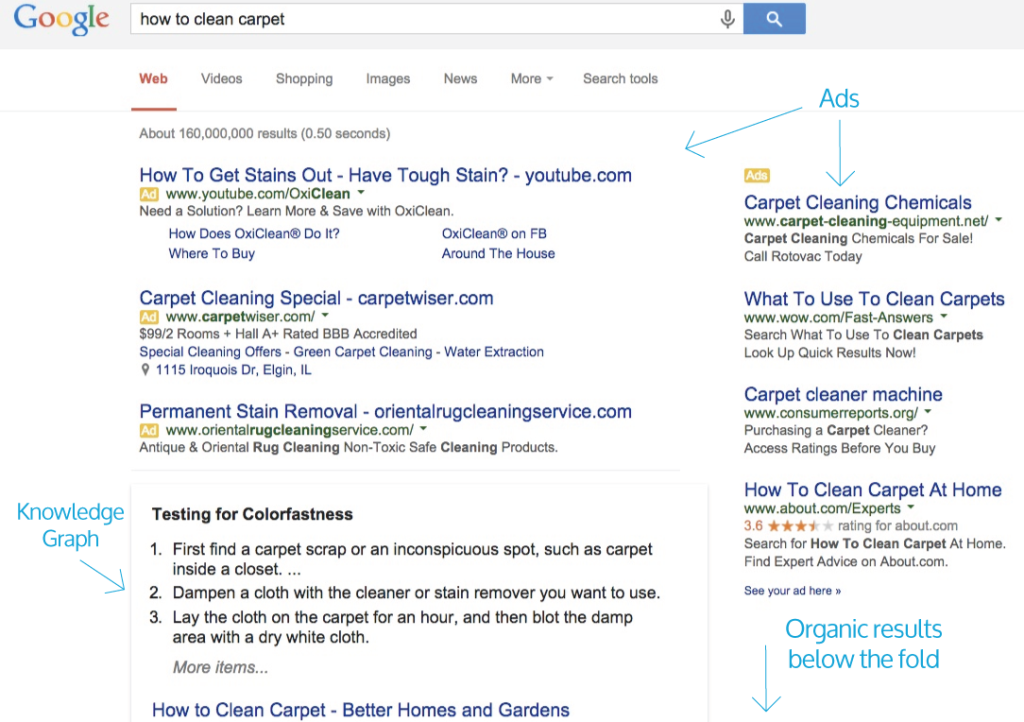What Most Marketers Don’t Know: The Knowledge Graph and the Future of SEO
Google’s Knowledge Graph has been changing the search result landscape for years, but some marketers aren’t even aware of it, and few know exactly what it is and how it works. The marketing community in general is still wrestling with what to actually do with the Knowledge Graph, and even some of the SEO-savvy are still scratching their heads. That is, until today. I am proud to announce the release a first-of-its-kind resource, The Essential Guide to Marketing with Google’s Knowledge Graph. Why write an ebook about the Knowledge Graph especially for marketers? Because it hasn’t been done before, and it’s desperately needed.
What the Knowledge Graph is Doing
The Knowledge Graph was officially released in May 2012, and in the first year after its release, Wikipedia — one of the primary sources of data for the Graph — saw a 21% decline in page views. Causation or correlation? One thing is for certain: As more quick facts, info, and How To’s are delivered to users right on Google search results, there are fewer reason for users to click through to any other website. The Knowledge Graph has already dramatically changing the layout of search results, and it continues today. 1 in 4 Google search results already include a Knowledge Graph offering. First, it filled in the right sidebar, where ads typically run. It might be a strategic use of space on the page, but it might also be a conspiracy to train users to trust content (ads) in the sidebar. Before long, it spread to the top of the main results column — pushing down organic listings.  Where the Knowledge Graph and sponsored ads appear at the top of the main results column, the coveted #1 Organic Listing can actually get pushed all the way below the fold.
Where the Knowledge Graph and sponsored ads appear at the top of the main results column, the coveted #1 Organic Listing can actually get pushed all the way below the fold.  The bottom line is that Google still makes most of their money from ads. Like any site selling ad space, they want to keep eyes on their landing pages as long as possible, and the Knowledge Graph is doing that.
The bottom line is that Google still makes most of their money from ads. Like any site selling ad space, they want to keep eyes on their landing pages as long as possible, and the Knowledge Graph is doing that.
What’s a Marketer to Do?
Even marketers who are aware of the Graph still aren’t always sure what it means for the future of their marketing efforts. Within the SEO community, many are fascinated by it and following it closely, but they are mostly worried and confused about what it could mean over the next few years.
What do I do if results for my search terms become more and more cluttered with Knowledge Graph entries?
Will the Knowledge Graph continue to expand into new categories and query types?
Can I still drive SEO improvements in spite of the knowledge Graph?
The best practices for marketers that want to respond to the Knowledge Graph proactively fall into four categories:
- Use updated SEO best practices to continue to earn organic search traffic — because of, or in spite of, the Knowledge Graph.
- Convert a high percentage of organic search traffic into your own proprietary audience (and nurture those leads).
- Ensure your online marketing strategy is not overly dependent on any one traffic source.
- Respond to the evolving demands of today’s users.
The Knowledge Graph is forcing savvy marketers to make changes, but even as it threatens, it also provides some unique opportunities.
Learn How to Market with the Knowledge Graph
Ready for more?
Grab your copy of The Essential Guide to Marketing with Google’s Knowledge Graph to see all of the ways it is disrupting search results, and get practical tools and strategies that will help you drive results through or around it. Bonus: We’ve also included dozens of screenshot examples so you can see nearly every type of Knowledge Graph result in the wild, as well as a detailed timeline of Knowledge Graph changes going all the way back to its first release in May 2012. I can’t wait to hear what you think! Please send me your feedback @seonate.
What's Next?
Profound Strategy is on a mission to help growth-minded marketers turn SEO back into a source of predictable, reliable, scalable business results.
Start winning in organic search and turn SEO into your most efficient marketing channel. Subscribe to updates and join the 6,000+ marketing executives and founders that are changing the way they do SEO:
And dig deeper with some of our best content, such as The CMO’s Guide to Modern SEO, Technical SEO: A Decision Maker’s Guide, and A Modern Framework for SEO Work that Matters.




![An Intro to Google Posts for B2B Marketers [Update: PDF Guide Now Available]](https://profoundstrategy.com/wp-content/uploads/cheap-seo-1030x350.jpg)